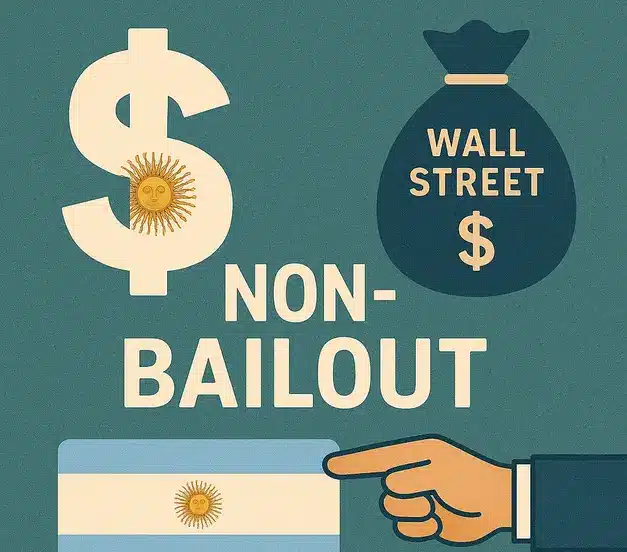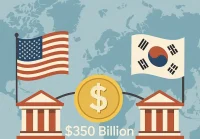The United States committed $40 billion to Argentina during a government shutdown, without congressional approval, debate, or public scrutiny. The Treasury Department used a mechanism few Americans have heard of—the Exchange Stabilization Fund, or ESF—a secret pool of money created in 1934 during the Great Depression.
President Franklin Roosevelt created the ESF by unilaterally revaluing gold from $20.67 to $35 per ounce, instantly declaring government gold reserves worth 70% more. That revaluation created billions in profits that Roosevelt locked away in a fund the Treasury could use to intervene in currency markets without congressional approval. This emergency stabilization fund has been used sparingly over nine decades: bailing out Mexico during the 1995 peso crisis, backing credit markets during 2008’s financial collapse, and supporting markets when the Fed ran out of interest rate ammunition during the pandemic.
Now it’s being deployed again, this time to prop up Argentina’s hyperinflated peso—a currency that has lost 200% of its value—while US taxpayers shoulder the risk if the currency continues collapsing.
Table of Contents
The “Not a Bailout” Bailout
Officials insist this isn’t a bailout. Treasury describes it as a “currency stabilization partnership” through a currency swap mechanism. The ESF buys Argentina’s pesos from their central bank, giving them US dollars in return. In theory, those pesos act as collateral. In practice, the Treasury holds hyperinflating currency—a melting ice cube—on behalf of American taxpayers.
Argentine president Javier Milei ran for election promising free markets and no state bailouts. He’s now receiving one of history’s largest bailouts while claiming adherence to those principles. The irony hasn’t been lost on observers.
The deal has two parts. The first $20 billion comes directly from the ESF, which effectively means taxpayers will pay if Argentina defaults. The second $20 billion comes from private investors and hedge funds, though these institutions only participate because the US Treasury guarantees their investment security.
Who Really Benefits?
Argentina ranks nowhere near America’s top trading partners—not in the top three, not even the top five. The official story claims this supports an ally aligned with MAGA values, helps stabilize a strategic Latin American economy, and prevents China from expanding influence in the region.
However, deeper investigation reveals connections between Wall Street funds, the Treasury Department, and substantial Argentine debt holdings. Discovery Capital, Soros Fund Management, and other major funds have billions invested in Argentina’s distressed bonds. These bonds trade between 25 and 35 cents on the dollar, prices indicating extremely high default probability.
Hedge funds bet that President Milei’s reforms would rescue Argentina’s economy through spending cuts and structural changes. Instead, inflation remained above 200%, the peso continued collapsing, and those bonds fell another 30%. Powerful people were losing substantial money on those wagers.
Then in July 2025, Treasury Secretary Scott Bessent—himself a former hedge fund manager who worked under George Soros at the Quantum Fund managing billions—stepped in with the ESF bailout mechanism. This stabilized Argentina’s currency and saved billions for funds holding distressed debt. Critics argue this represents taxpayer-funded rescue of billionaire investors who made losing bets.
The Treasury Secretary’s Background
Treasury Secretary Bessent represents someone with deep Wall Street connections now approving massive bailouts of countries where former colleagues have invested heavily. Bessent managed billions at Soros Fund Management, working alongside people who run funds holding substantial Argentine debt positions.
This doesn’t necessarily indicate illegal activity, but the optics create concerns about conflicts of interest. The person approving a $40 billion Argentina rescue is someone who spent decades making money from currency trades and distressed debt investments in emerging markets.
The China Factor
Beyond Wall Street beneficiaries, this intervention serves broader geo-economic strategy. Treasury Secretary Bessent has been explicit about wanting the United States to reclaim global market leadership after decades of China and international institutions dominating developing world finance.
China has been building what analysts call a “gold corridor”—a network of vaults across Asia, Africa, and Latin America creating a parallel financial system backed by gold. Meanwhile, China’s banks have lent Argentina billions for power plants, railways, and nuclear projects, pulling the country toward China’s sphere of influence.
The US intervention sends a message that America retains power to stabilize economies globally. China lends yuan backed by gold. America lends dollars backed by Treasury securities. Argentina became a test case because it represents a Latin American country gradually aligning more closely with China.
The Hidden Cost to Americans
This bailout has real consequences for ordinary Americans, particularly farmers struggling with drought conditions and high costs. President Trump floated importing beef from Argentina, which cattle ranchers say will devastate domestic producers already facing economic pressure.
If the peso continues collapsing and Argentina defaults, the Treasury absorbs losses, creating shortfalls filled through new debt. Taxpayers ultimately repay that debt through future tax burdens. The arrangement effectively subsidizes foreign agricultural competition while risking billions in taxpayer funds.
The program sets potentially dangerous precedent. If the US government will save billionaire investors when their bets go bad—as long as the rescue can be framed as defending American values or the dollar—it incentivizes risky behavior knowing the backstop exists.
The Pattern Repeats
America already runs multi-trillion dollar deficits, borrowing to fund domestic programs. Somehow, officials claim an extra $40 billion exists to gamble on a foreign hyperinflated currency. This doesn’t make economic sense unless the rescue serves broader strategic purposes beyond Argentina itself.
The timing suggests this represents one move in a larger geo-economic competition. Rumors circulate about additional “currency stabilization partnerships” targeting Brazil, Colombia, Egypt, and Kenya. Countries across Latin America—Argentina, Paraguay, Ecuador, Bolivia—owe tens of billions to China through Belt and Road infrastructure loans, now drowning in debt.
These nations represent ideal candidates for American intervention. Brazil owes China tens of billions through state banks and is part of the BRICS bloc. Colombia’s peso fell 20% last year while facing inflation pressure. Egypt, one of China’s biggest African borrowers, teeters on the verge of another IMF rescue.
The Obama administration missed opportunities when Latin American governments shifted center-right over eight years. Now the Trump administration is seizing that opening to pull these countries back from Chinese influence into America’s sphere.
Conditional Support
The arrangement remains conditional on Argentine political outcomes. President Trump told Milei his administration will remain supportive if Milei wins re-election, but America will exit if he loses. This conditional support reveals the geo-political rather than purely economic nature of the intervention.
The US is essentially betting on Milei’s political survival to maintain influence. If his reforms successfully stabilize Argentina’s economy, it demonstrates American intervention effectiveness and encourages other countries to seek US assistance rather than turning to China.
Conditional Support and Geopolitical Strategy
U.S. backing for Argentina under Milei isn’t purely economic — it’s strategic. Conditional support tied to political outcomes underscores Washington’s intent to influence regional stability and counter China’s growing presence. Economic recovery becomes a proxy for geopolitical positioning in Latin America’s evolving power balance.
Explore Geopolitical & Economic Policy Roles →A New Financial War
This represents one battle in America’s financial competition with China. On one side, China offers yuan loans backed by physical gold, creating tangible value through precious metal reserves. On the other, America offers dollar loans backed by Treasury securities, creating value through faith in American economic strength.
Both superpowers are attempting to reshape global financial architecture toward their preferred system. The ESF deployment to Argentina signals Washington’s willingness to use taxpayer risk to compete for influence, even when the direct beneficiaries appear to be hedge fund managers rather than ordinary Americans.
The Exchange Stabilization Fund was designed for emergency stabilization during the Great Depression. Now it’s being deployed as an offensive weapon in America’s financial competition with China, while simultaneously rescuing Wall Street firms from distressed debt losses. Whether taxpayers ultimately benefit remains unclear, but the precedent it establishes could reshape expectations about government intervention in markets.
Frequently Asked Questions
Q: What is the Exchange Stabilization Fund (ESF)?
A: The ESF is a secret Treasury fund created in 1934 when Roosevelt revalued gold, creating billions in locked profits the Treasury can use for currency market intervention without congressional approval.
Q: Why is the US bailing out Argentina?
A: Officials claim it’s to support an ally and defend the dollar against China’s growing influence in Latin America, though critics argue it rescues hedge funds holding Argentina’s distressed debt and sets a precedent for taxpayer-funded investor rescues.
Q: How does the currency swap work?
A: The Treasury buys Argentina’s hyperinflated pesos through the ESF, giving Argentina US dollars. The pesos serve as collateral, but if they collapse further, taxpayers absorb losses through Treasury shortfalls filled by new debt.
Q: Who benefits from this arrangement?
A: Argentina gains currency stability, hedge funds like Discovery Capital and Soros Fund Management save billions on distressed bonds, China loses influence in Latin America, and US farmers potentially face competition from Argentine beef imports.
Q: Why wasn’t Congress involved?
A: The ESF operates without congressional approval due to its 1934 origins. Treasury Secretary Scott Bessent, a former hedge fund manager, authorized the intervention while Congress was focused on the government shutdown.
Q: What happens if Milei loses re-election?
A: President Trump stated that if Milei doesn’t win, the US will withdraw support, suggesting the bailout is conditional on maintaining a political ally rather than purely economic stabilization.




